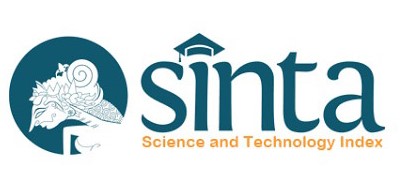Continuous Ketamine Administration Decreases Monocyte Count in Sepsis Patients in Intensive Care Units
Abstract
Background: Cytokines storm becomes the most common cause of mortality in sepsis patients treated in the intensive care unit (ICU). Cytokines storm is characterized by an excessive elevation in the immunocompetent cells, including monocyte. Ketamine, as a sedating agent, has immunosuppressive properties. This study was conducted to determine the effect of ketamine on monocyte count in septic patients in the ICU.
Methods: This is a quantitative case-control study of 30 patients treated in the ICU. The study subjects were divided into control (n=15) and treatment (n=15) groups. The treatment group received ketamine HCl therapy at 0.3 mg/kg body weight/hour. The mean monocytes were counted at 0, 24, and 48 hours post-therapy. Data analysis used an independent sample t-test with α=5%.
Result: Administration of ketamine therapy in septic patients treated in the ICU showed a decrease in the monocytes during observation from 0 to 48 hours post-therapy. Administration of ketamine at 48 hours had a significantly lower monocyte (5.21%) compared to control (7.67%) (p=0.012).
Conclusion: Ketamine administration reduces the monocytes count in septic patients treated in the intensive care unit. Ketamine is expected to be a therapeutic option in sepsis patients.
Keywords
Full Text:
PDFReferences
Sakr Y, Jaschinski U, Wittebole X, et al. Sepsis in intensive care unit patients: Worldwide data from the intensive care over nations audit. Open Forum Infect Dis. 2018;5(12):1-9. doi:10.1093/ofid/ofy313
Dugar S, Choudhary C, Duggal A. Sepsis and septic shock: Guideline-based management. Cleve Clin J Med. 2020;87(1):53-64. doi:10.3949/ccjm.87a.18143
Fujishima S. Organ dysfunction as a new standard for defining sepsis. Inflamm Regen. 2016;36(1):1-6. doi:10.1186/s41232-016-0029-y
Alberts B, Johnson A, Lewis, J et al. Molecular Biology of the Cell. In: Innate Immunity. 4th editio. Garland Science; 2002.
Justiz VA, Sabir S, Jan A. Physiology, Immune Response. StatPearls Publishing; 2022. https://www.ncbi.nlm.nih.gov/books/NBK539801
Zhang J-M, Jianxiong A. Cytokines, Inflammation and Pain. Int Anesth Clin. 2007;45(2):27-37. doi:10.1097/AIA.0b013e318034194e.
Taniguchi T, Takemoto Y, Kanakura H, Kidani Y, Yamamoto K. The Dose-Related Effects of Ketamine on Mortality and Cytokine Responses to Endotoxin-Induced Shock in Rats. Anesth Analg. 2003;97(6):1769-1772. doi:10.1213/01.ANE.0000085634.72426.ED
Van Hinsbergh VWM. Endothelium - Role in regulation of coagulation and inflammation. Semin Immunopathol. 2012;34(1):93-106. doi:10.1007/s00281-011-0285-5
Conway Morris A, Datta D, Shankar-Hari M, et al. Cell-surface signatures of immune dysfunction risk-stratify critically ill patients: INFECT study. Intensive Care Med. 2018;44(5):627-635. doi:10.1007/s00134-018-5247-0
Asmoro AA, Jaya W, Nasiqah A, Rodli M. Immunomodulator effect of ketamine on rat models of sepsis (fecal induced peritonitis): Eosinophil and monocyte modulation. Anaesthesia, Pain Intensive Care. 2020;24(3):279-283. doi:10.35975/apic.v24i3.1279
Cruz FF, Rocco PRM, Pelosi P. Anti-inflammatory properties of anesthetic agents. Crit Care. 2017;21(1). doi:10.1186/s13054-017-1645-x
Hortová-Kohoutková M, Lázničková P, Bendíčková K, et al. Differences in monocyte subsets are associated with short-term survival in patients with septic shock. J Cell Mol Med. 2020;24(21):12504-12512. doi:10.1111/jcmm.15791
Lee AJ, Kim SG. Mean cell volumes of neutrophils and monocytes are promising markers of sepsis in elderly patients. Blood Res. 2013;48(3):193-197. doi:10.5045/br.2013.48.3.193
Chung H, Lee JH, Jo YH, Hwang JE, Kim J. Circulating Monocyte Counts and its Impact on Outcomes in Patients with Severe Sepsis Including Septic Shock. Shock. 2019;51(4):423-429. doi:10.1097/SHK.0000000000001193
De Kock M, Loix S, Lavand’homme P. Ketamine and Peripheral Inflammation. CNS Neurosci Ther. 2013;19(6):403-410. doi:10.1111/cns.12104
Lange M, Bröking K, Van Aken H, Hucklenbruch C, Bone HG, Westphal M. Einsatz von ketamin bei sepsis und systemischen entzündungsreaktionen. Anaesthesist. 2006;55(8):883-891. doi:10.1007/s00101-006-1048-x
Schulte W, Bernhagen J, Bucala R. Cytokines in sepsis: Potent immunoregulators and potential therapeutic targets - An updated view. Mediators Inflamm. 2013;2013. doi:10.1155/2013/165974
Mehta P, Fajgenbaum DC. Is severe COVID-19 a cytokine storm syndrome: a hyperinflammatory debate. Curr Opin Rheumatol. 2021;33(5):419-430. doi:10.1097/BOR.0000000000000822
Jacobi J. Sepsis: A frequent, life-threatening syndrome. Pharmacotherapy. 2002;22(12 II). doi:10.1592/phco.22.18.169s.33705
Hotchkiss RS, Monneret G, Payen D. Sepsis-induced immunosuppression: from cellular dysfunctions to immunotherapy. Nat Rev Immunol. 2013;13(12):862-874. doi:10.1038/nri3552
Zorumski CF, Izumi Y, Mennerick S. Ketamine: NMDA receptors and beyond. J Neurosci. 2016;36(44):11158-11164. doi:10.1523/JNEUROSCI.1547-16.2016
Heinz P, Geelhoed GC, Wee C, Pascoe EM. Is atropine needed with ketamine sedation? A prospective, randomised, double blind study. Emerg Med J. 2006;23(3):206-209. doi:10.1136/emj.2005.028969
Groetzinger L, Rivosecchi R, Bain W, et al. Ketamine Infusion for Adjunct Sedation in Mechanically Ventilated Adults. Int J Lab Hematol. 2017;38(1):42-49. doi:https://doi.org/10.1002/phar.2065
Beilin B, Rusabrov Y, Shapira Y, et al. Low-dose ketamine affects immune responses in humans during the early postoperative period. Br J Anaesth. 2007;99(4):522-527. doi:10.1093/bja/aem218
Ali H, Mokhtar A. Effect of single compared to repeated doses of intravenous S(+) ketamine on the release of pro-inflammatory cytokines in patients undergoing radical prostatectomy. Anesth Essays Res. 2017;11(2):282. doi:10.4103/aer.aer_28_17
DOI: http://dx.doi.org/10.21776/ub.jap.2023.004.01.01
Refbacks
- There are currently no refbacks.

This work is licensed under a Creative Commons Attribution 4.0 International License.









.png)

